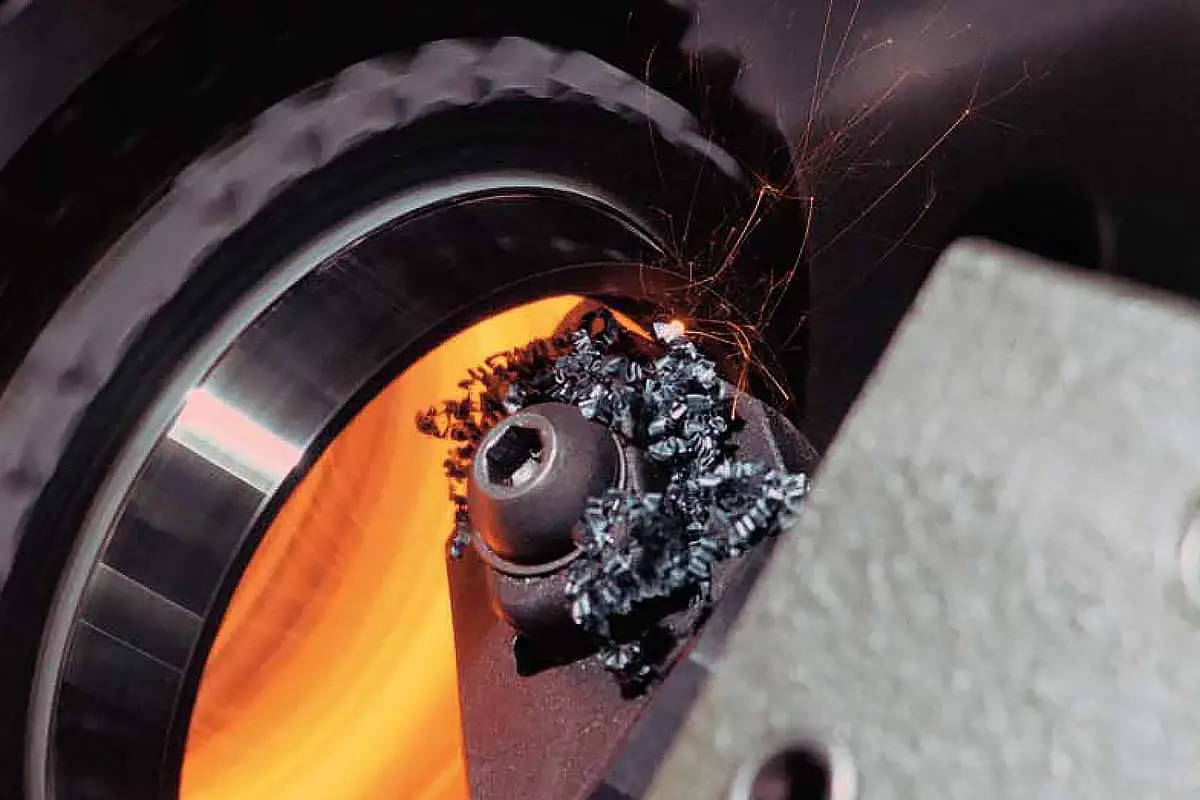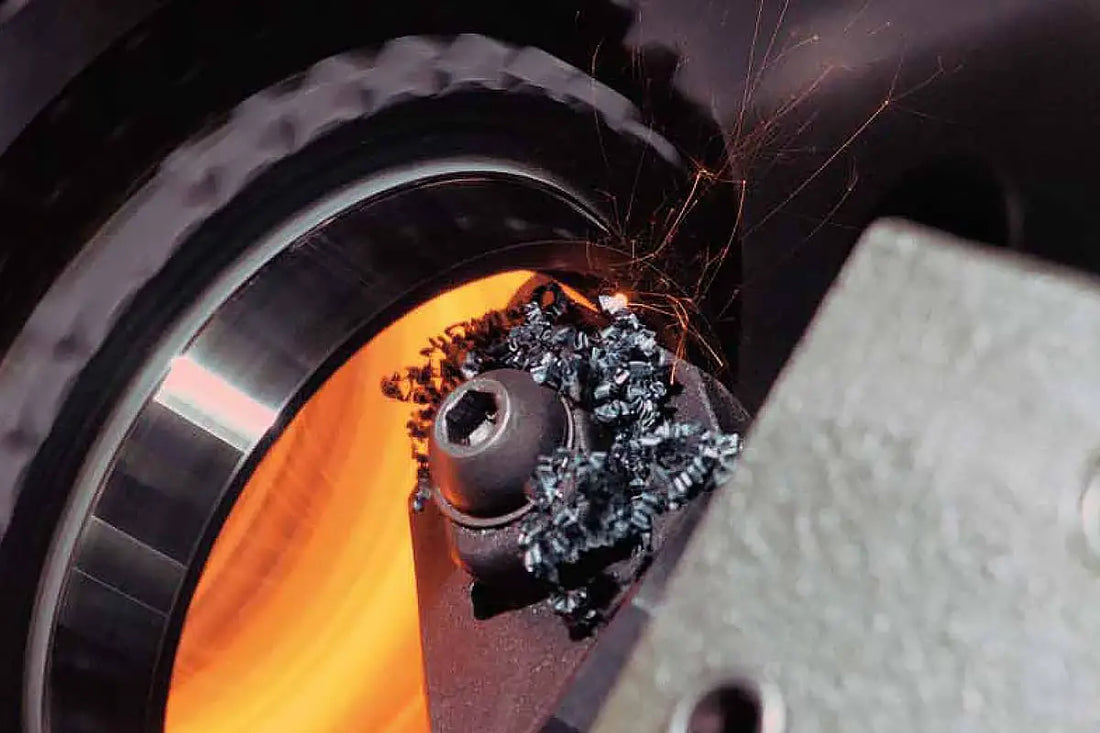Dry machining background
Currently, most machine part processing, especially on highly automated CNC machine tools, machining centers and production lines, involves the use of cutting fluids. The main functions of cutting fluids are to remove chips, reduce cutting temperatures and provide lubrication.

Dry machining, in simple terms, is a machining process that does not use cutting fluids. Since the beginning of metal cutting technology, both dry and wet cutting methods have been employed. Thus, the principle of dry machining is not new and has been applied in production for a considerable time (such as in dry milling of cast iron).
However, the context has changed significantly because dry machining is no longer limited to processing cast iron materials and conventional natural methods. Instead, it strives to apply dry machining to the processing of all materials and methods by establishing new theories and techniques.
Dry machining is not just about stopping the use of cutting fluids. It is about maintaining high efficiency, product quality, tool life and reliability in the cutting process by minimizing or eliminating the use of cutting fluids. This requires the use of high-performance dry machining tools, machine tools and auxiliary installations to replace the role of cutting fluids in traditional cutting and achieve true dry machining.
Dry machining involves various aspects such as tool materials, tool coatings, tool geometry, machining machines, cutting parameters and processing methods. It represents an intersection and integration of manufacturing technology with materials science, information technology, electronics, and management disciplines.
Dry machining aims to eliminate the adverse effects of cutting fluids in turning, milling, drilling and boring processes, significantly reducing processing costs and protecting the ecological environment.
Currently, industrialized countries such as Europe and Japan are paying great attention to the development and application of dry machining technology. Statistics show that around 10% to 15% of machining in the European industrial sector has adopted dry machining processes.
In the 21st century, the manufacturing industry's demand for green and environmentally friendly processes is increasing. Dry machining technology, as a green manufacturing process, is significant for resource conservation, environmental protection and cost reduction.
With the advancement of machine tool technology, cutting tool technology and related process research, dry machining is set to become the main means of metal cutting and gain wide application.
At present, the scope of dry machining processing is still relatively limited, but its in-depth research and wide application have become a hot topic in the field of machining. Israeli experts believe that dry machining “remains a complex field to this day. It’s not just a matter of turning off the coolant and ordering a new tool.”
In recent years, along with the development of high-speed cutting technology, the mechanical manufacturing industry in industrialized countries has been exploring new dry machining processes using existing tool materials.
Meaningful and economically viable dry machining must be based on a careful analysis of specific boundary conditions and a thorough understanding of the complex factors that influence dry machining. This analysis provides the data and materials necessary for the design of dry machining process systems.
Dry Machining Terminology and Definitions
Dry machining research and applications have received widespread attention both nationally and internationally, with years of research driving the implementation of dry machining technology.
However, experts and scholars have varying descriptions of the terminology and definitions related to dry machining. The proposed national standard provides regulations: The standard applies to mechanical product machining processes involving complete dry machining and assisted dry machining (including air cooling, liquid nitrogen cooling, laser assisted, etc.).
Dry Machining (Dry Cutting): A machining process that does not use any cutting fluid during the cutting process.
Complete Dry Machining: A machining process that does not use any cutting fluid or auxiliary cooling medium during the cutting process.
Sub-Dry Machining (Sub-Dry Cutting): A cutting technology that involves injecting a suitable amount of lubricant into an air stream at certain pressures and temperatures, creating a mist mixture, which then forms a minimal amount of medium lubricant and is sprayed into the cutting zone for targeted micro-lubrication and cooling. of the heat-affected area.
Sub-dry machining generally includes: minimum quantity lubrication cutting, low temperature minimum quantity lubrication cutting (cold air cutting), minimum quantity lubrication cutting with shielding gas, internal coolant jetting and spraying technologies mixed.
The aforementioned terms and definitions provide a basic distinction and standardization between dry cutting and sub-dry cutting. As research deepens and technology advances, standards also undergo a continuous process of improvement and refinement. For example, in the definition of sub-dry cutting (sub-dry machining), “inject an adequate amount of lubricant” should be revised to “inject an adequate amount of cooling and lubricating medium” to form a mist mixture with air in certain pressures and temperatures, creating a micro-cooling lubricating medium that is sprayed onto the cutting area for targeted micro-cooling and lubrication of the heat-affected zone.
Dry machining functions
Cooling effect
The cooling effect removes heat generated during cutting, reduces tool wear and prevents oxidation of the workpiece surface.
Lubricating Effect
Reduces friction, decreases cutting forces and ensures smooth cutting operations.
Chip removal
The process quickly removes chips from the surface of the part, preventing them from scratching the surface.
However, from the point of view of environmental protection, the negative impacts of cutting fluids are increasingly evident, as can be seen in the following aspects:
- The high temperatures generated during machining cause the cutting fluid to vaporize, forming a mist, contaminating the environment and posing health risks to operators.
- Certain cutting fluids and the chips contaminated with them must be treated as toxic and hazardous materials, incurring substantial disposal costs.
- Cutting fluid leaks and spills significantly impact safe production practices.
- Additives in cutting fluids, such as sulfur and chlorine, can harm operators' health and affect machining quality.
Furthermore, extensive research into the cutting process has revealed that the traditional functions of cutting fluids in cooling, lubricating and chip removal are not fully and effectively utilized in many machining processes, especially in high-speed cutting.
As a result, efforts are being made to reduce or eliminate the use of cutting fluids, adapting to clean production processes and reducing production costs.
Dry machining technology emerged under these circumstances as an advanced machining method. Adopting dry machining technology not only reduces environmental pollution caused by cutting fluids and improves operators' working conditions, but also eliminates expenses related to cutting fluids and reduces the cost of recycling and chip disposal.
Dry machining technology places greater demands on machine tool and cutting tool technology. In recent years, industrially advanced countries have placed great emphasis on dry machining research. Dry cutting machining, as a new method, represents one of the future trends in metal cutting technology.
Characteristics of the dry machining process
Dry machining, which eliminates the use of cutting fluids, completely eradicates a number of negative effects associated with their use during machining.
Compared to wet cutting, dry machining offers the following advantages:
- The resulting filings are clean, uncontaminated, and easy to recycle and dispose of.
- Eliminates the need for fluid transport, filtration and recovery systems, simplifying the production process and reducing manufacturing costs.
- Saves on expenses related to the use of cutting fluids and chip disposal.
- Does not contribute to environmental pollution or safety and quality incidents associated with cutting fluids. Due to these characteristics, dry machining has become a focal point in research into clean manufacturing processes and has been successfully applied in turning, milling, drilling and boring operations.
However, compared to wet cutting under the same conditions, dry machining has some disadvantages:
- Direct machining energy consumption (strain and friction energy) increases, resulting in higher cutting temperatures.
- The state of friction and wear mechanisms in the tool/chip contact area change, accelerating tool wear.
- Chips are more difficult to break and control due to their greater thermoplasticity, making their collection and removal more challenging.
- The quality of the machined surface is subject to deterioration.
Dry machining process technology
The material of the part largely determines the feasibility of implementing dry machining. Improving the machinability of materials and reducing the heat generated by deformation and friction during the cutting process are technical measures for the development of dry machining.
For example, easily machinable steels and cast irons were developed. Part materials differ significantly in thermal properties; dry machining requires large thermal capacity and low thermal conductivity. Therefore, large mass parts are more suitable for dry machining than small mass parts.
High forces and cutting temperatures are the main characteristics of dry machining. To reduce material adhesion and diffusion between the tool and the workpiece at high temperatures and to ensure normal tool life, special attention should be paid to the proper match between tool materials and workpieces.
Once the tool has been determined, suitable cutting parameters and other variables must be selected based on the specific machining process. In dry machining operations, high cutting speeds are recommended as they facilitate faster chip removal and heat dissipation, which is highly beneficial for extending tool life.
Current dry machining technologies include low-temperature air cooling, high-speed dry machining, low-temperature dry machining, electrostatic cooling, minimum quantity lubrication (MQL), and near-dry machining techniques.
Requirements for cutting tools in dry machining
1. Excellent thermal hardness and wear resistance.
Dry machining typically generates much higher cutting temperatures than wet machining. Only cutting tool materials with high thermal hardness can effectively withstand the high temperatures of the cutting process and maintain good wear resistance. The hardness of the tool material must be at least four times that of the workpiece material.
2. Low coefficient of friction.
Reducing the friction coefficient between the tool and the chips, as well as between the tool and the workpiece surface, can partially replace the lubricating effect of cutting fluids and suppress the increase in cutting temperature.
3. High toughness at elevated temperatures.
The cutting forces during dry machining are greater than those during wet machining, and the cutting conditions for dry machining are more challenging; therefore, the tools require high toughness at elevated temperatures.
4. High thermochemical stability.
Under the high temperatures of dry machining, cutting tools must maintain high chemical stability to minimize the catalytic effects of heat on chemical reactions, thus prolonging tool life.
5. Reasonably structured tool geometry and angles.
Properly structured tool geometry and angles can not only reduce cutting forces, prevent the formation of built-up edges and reduce cutting temperatures, but also control chip flow and breakage. The shape of the tool ensures smooth chip flow and facilitates heat dissipation.

























































